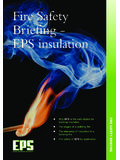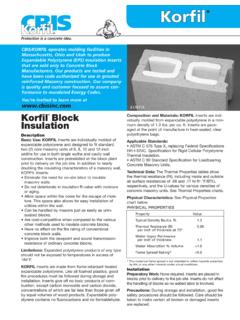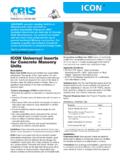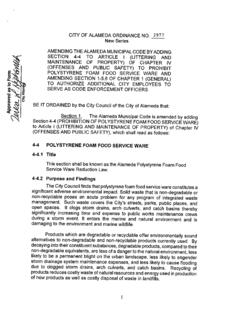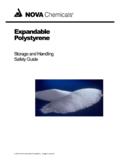Transcription of Expanded Polystyrene (EPS) and the Environment
1 Expanded Polystyrene (EPS). and the Environment Introduction The impact on the Environment of everyday materials is increasingly important if we are to reduce our carbon footprint and protect our natural heritage for future generations. Our aim, therefore, in this booklet is to provide you with factual, well-documented information about the environmental credentials of EPS. EPS ( Expanded Polystyrene ) is an excellent material for packaging and for construction as it is a light yet rigid foam with good thermal insulation and high impact resistance. This publication aims to provide balanced information based on the manufacture, use and recovery from waste of EPS in the packaging and construction sectors. We also aim to demonstrate to customers, government organisations, consumer associations and the public that, by choosing or using EPS, you can be confident it is safe, complies with all relevant technical and environmental standards and can easily be recycled at the end of its primary use.
2 What is EPS? Expanded Polystyrene (EPS) is a rigid cellular plastic, which is found in a multitude of shapes and applications. It is used for fish boxes, packaging for electrical consumer goods and for insulation panels for building. These are the most commonly known uses and we will mention others in this document. XPS (extruded Polystyrene ) is also plastic foam based on Polystyrene that is formed by adding gas during extrusion not by expanding beads containing gas; which is how EPS is formed. A well-known use of XPS is the vac-formed Polystyrene trays used for small portions of food that we see in the supermarket. The extruded Polystyrene foam is a fine laminate that is only 2-3 mm thick. Raw Material Expanded Polystyrene is made from expandable Polystyrene , which is a rigid cellular plastic containing an expansion agent. EPS is obtained from oil as can be CRUDE. seen from the diagram. OIL. DISTILLATION.
3 HYDROCARBON OTHER. FUELS. SEPARATION DERIVATIVES. Ethanes Gasoline Alkenes Bulk tar Diesel Fuel Kerosene Lubricants Asphalt Fuel Oils Liquid Wax Petroleum Jet Fuel Petroleum Gas Sulfur or Coke Natural Gas Sulfuric Acid Paraffin wax Generally used in transportation, power Over 4000 products, compounds plants and heating. Normally results in PLASTICS through polymerisation processes, the destruction of the material while 4% motor oils and greases, acids and generating energy. further derivatives EPS OTHERS. 0 1% 96%. Expanded Polystyrene (EPS) AND THE Environment PAGE 2. Manufacturing Process We can see from the diagram that EPS is brought to us from the oil well through a chemical process. Now we will see what happens in the transformation that leads us to Expanded Polystyrene (EPS). The conversion of expandable Polystyrene to Expanded Polystyrene is carried out in three stages. RAW. MATERIAL. PRE- EXPANDER.
4 PRE- EXPANSION 1. SILOS. INTERMEDIATE. MATURING 2. BLOCKS SHAPE. MOULDING MOULDING. BLOCK. CUTTING. FINAL. MOULDING 3. PLANT. BOARDS MOULDED. ARTICLES. 1st stage 2nd stage 3rd stage Pre-expansion Intermediate Maturing and Expansion and Final The raw material is heated in special Stabilisation Moulding machines called pre-expanders with On cooling, the recently Expanded particles During this stage, the stabilised steam at temperatures of between from a vacuum in their interior and this must pre- Expanded beads are 80-100 C. The density of the material be compensated for by air diffusion. This transported to moulds where falls from some 630kg/m3 to values of process is carried out during the material's they are again subjected to steam between 10 and 35kg/m3. intermediate maturing in aerated silos. The so that the beads bind together. During this process of pre- beads are dried at the same time. In this way moulded shapes expansion the raw material's compact This is how the beads achieve greater or large blocks are obtained beads turn into cellular plastic beads mechanical elasticity and improve expansion (that are later sectioned to the with small closed cells that hold air in capacity very important in the following required shape like boards, their interior.)
5 Transformation stage. panels, cylinders etc). Expanded Polystyrene (EPS) AND THE Environment PAGE 3. Applications and Properties of EPS. The range of applications for Expanded Polystyrene is very wide. We are going to focus on these applications by putting them into three main categories and underline the properties that make EPS ideal for each one. The three categories are: l Packaging l Construction l Other applications Packaging Any product of any shape or size may be packaged in Expanded Polystyrene . The following range of applications only scratches the surface of what could be possible. The following only scratches the surface of what is possible in both the industrial and food packaging sectors using EPS. Packing Products EPS is the best packaging option for almost any high value heavy product. Completely protected and safe from risk in transport and handling, EPS provides total protection for industrial products.
6 These range from fragile pharmaceutical products to electronic components, electrical consumer goods, toys through to horticultural or garden products. All of these, and more, are able to arrive at their destination often the home of the consumer in perfect condition courtesy of their EPS packaging. EPS can be designed to fit perfectly into automated production lines, which include the packing of the product. The EPS pack adapts superbly to integrated production systems. The EPS packaging system is often the best alternative in terms of cost, versatility and efficiency. It is easy for workers to handle with no sharp edges or staples and can work equally well with sophisticated machinery. Food Packaging Fish and shellfish, meat, fruit, ice cream EPS packaging is the best way of keeping any foodstuff fresh. The perfect protection avoids hazards, breakages and wastage in the different stages of production and transport.
7 Every day EPS. packaging is ensuring that many different foods reach the retailer or the final consumer in perfect condition. Food safety is paramount; a badly protected or poorly insulated product could arrive in a substandard condition. This could be a serious health risk to consumers or a serious wastage issue for a supermarket or food supplier. This is an important ecological benefit of EPS. Its capacity to conserve food helps to reduce wastage of food and guarantees food safety. New Applications for Moulded EPS. The versatility of EPS it can be moulded into almost any shape allows it to be used for a huge variety of different purposes. Examples include: l Chairs as designed by Tom Dixon l Book covers designed by Jonathan Ive for Sir Paul Smith's book l Exhibition stand designed by Michael Sodeau l Snow sports helmet l Infant car seats l Air conditioning units l Houses l Seating for sports Formula 1 cars and para-Olympic sailors l Frog houses l load-bearing structurally insulated panels (SIP's).
8 Expanded Polystyrene (EPS) AND THE Environment PAGE 4. Properties of EPS. The following properties make EPS a perfect packaging material: Shock absorption The material has a high energy absorption index. This makes it the ideal material for protecting sensitive products during transport and storage. This unique level of protection makes EPS ideally suited for safety and sports helmets and for children's car seats. Thermal insulation Due to its closed cell structure, which inhibits the passage of heat or cold, EPS has a high capacity for thermal insulation. This protects products such as vaccines or other pharmaceutical items and food such as fish and meat from sudden changes in temperature. Low weight EPS is 98% air making it the lightest packaging material available. This reduces the overall packaging weight and provides savings in fuel consumption . reducing the environmental impact of transporting products.
9 Retention of vitamin C. When packed in EPS, fruits and vegetables retain their vitamin C content longer than food packaging in other materials. Resistance to humidity The excellent mechanical and thermal properties are unaffected by humidity because EPS does not absorb water or water vapour. Compressive resistance The unique ability of EPS to resist compression makes it ideal for packing large items such as cookers and washing machines. Not only does EPS protect them in transit, but they can be stacked in the warehouse, saving on space and without any damage to the items. Chemical resistance Allows many products to be packed without the goods being affected. Display effect to promote sales EPS can easily be printed or coloured, it has a clean appealing appearance and can be used in many different ways to dress products to attract customers. Hygienic nature EPS is completely inert and innocuous, it meets all the food contact regulatory standards and can be used to package food or pharmaceuticals.
10 Expanded Polystyrene (EPS) AND THE Environment PAGE 5. Applications as a Construction Material EPS is used in many aspects of building work including large structures such as roads, bridges, railway lines, public buildings or even small family residences. The characteristics of EPS make it ideal for use as a lightweight filler, insulation, as an element for decorating or imaginative touches, as a lightweight filling material in roads, to facilitate land drainage and so on. We could visit any construction or building site and find products made from EPS carrying out diverse and important functions. The following properties are important for these applications: Low thermal conductivity Due to its closed air-filled cell structure that inhibits the passage of heat or cold, a high capacity for thermal insulation is achieved. Low weight Densities of between 10 and 35kg/m2 allow light and safe construction works Mechanical resistance EPS has excellent mechanical properties making it good choice for load-bearing roof insulation, sub-pavement flooring, road-building, as load- bearing insulation, and so on.
